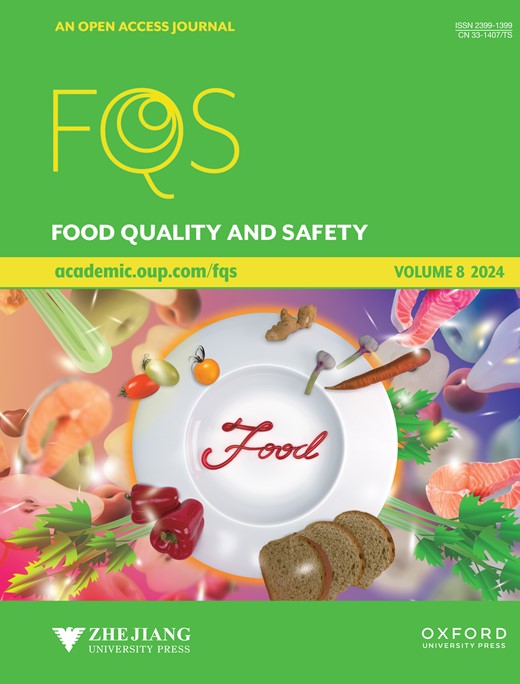从鱼类安全食用的角度,通过Th1/Th2免疫平衡和细胞因子释放对多种鱼类细小蛋白交叉致敏的洞察分析
IF 4.4
3区 农林科学
Q2 FOOD SCIENCE & TECHNOLOGY
引用次数: 2
摘要
Parvalbumin是鱼类中发现的主要过敏原,具有高度保守性。根据一些研究,一些鱼类过敏患者只对一种鱼类过敏,但对其他鱼类耐受;然而,根本机制尚未确定。使用BALB/c小鼠和RBL-2H3细胞模型测定了这七种基于大菱鲆PV处理小鼠的鱼细小蛋白的交叉反应性。同时,使用免疫信息学工具来评估交叉反应性。结果表明,研究的7种鱼类(大菱鲆、大黄鱼、鲈鱼、草鱼、鲤鱼、黄鳝和日本鳗)表现出不同程度的交叉反应,其中大菱鲆和鲈鱼的交叉反应最高,大菱鲆与黄鳝的交叉反应最低。生物信息学分析表明,黄鳝和大菱鲆的细小白蛋白序列同源性最低,这可能是黄鳝与大菱鲆的交叉反应如此有限的原因。Parvalbumin是大菱鲆、大黄鱼、鲈鱼、草鱼、鲤鱼、黄鳝和日本鳗中发现的一种强效交叉反应性过敏原,其中黄鳝与大菱鲆的交叉反应性最弱。本研究表明,黄鳝PV和大菱鲆PV之间的交叉反应性最弱。本文章由计算机程序翻译,如有差异,请以英文原文为准。
Insight analysis of the cross sensitisation of multiple fish parvalbumins via the Th1/Th2 immunological balance and cytokine release from the perspective of safe consumption of fish
Parvalbumin is the primary allergen found in fish and is highly conserved. According to some studies, some patients with fish allergy are allergic to only one species of fish but are tolerant to others; however, the underlying mechanism has not been identified.
The cross reactivity of these seven fish parvalbumins based on turbot PV treated mice was determined using BALB/c mouse and RBL-2H3 cell models. Meanwhile, immunoinformatic tools were used to assess cross reactivity.
The results indicated that the seven species of fishes (turbot, large yellow croaker, sea bass, grass carp, common carp, conger eel and Japanese eel) studied exhibited varying degrees of cross reactivity, with the highest cross reactivity being between turbot and bass and the lowest being between turbot and conger eel. The bioinformatics analysis revealed that the sequence homology of parvalbumin between conger eel and turbot was the lowest, which may account for the conger eel and turbot cross reaction being so limited. Parvalbumin was a potent cross-reactive allergen found in turbot, large yellow croaker, sea bass, grass carp, common carp, conger eel and Japanese eel, and the cross reactivity between conger eel and turbot parvalbumin was the weakest.
This study demonstrated that the cross reactivity between conger eel PV and turbot PV was the weakest.
求助全文
通过发布文献求助,成功后即可免费获取论文全文。
去求助
来源期刊

Food Quality and Safety
FOOD SCIENCE & TECHNOLOGY-
CiteScore
7.20
自引率
1.80%
发文量
31
审稿时长
5 weeks
期刊介绍:
Food quality and safety are the main targets of investigation in food production. Therefore, reliable paths to detect, identify, quantify, characterize and monitor quality and safety issues occurring in food are of great interest.
Food Quality and Safety is an open access, international, peer-reviewed journal providing a platform to highlight emerging and innovative science and technology in the agro-food field, publishing up-to-date research in the areas of food quality and safety, food nutrition and human health. It promotes food and health equity which will consequently promote public health and combat diseases.
The journal is an effective channel of communication between food scientists, nutritionists, public health professionals, food producers, food marketers, policy makers, governmental and non-governmental agencies, and others concerned with the food safety, nutrition and public health dimensions.
The journal accepts original research articles, review papers, technical reports, case studies, conference reports, and book reviews articles.
 求助内容:
求助内容: 应助结果提醒方式:
应助结果提醒方式:


